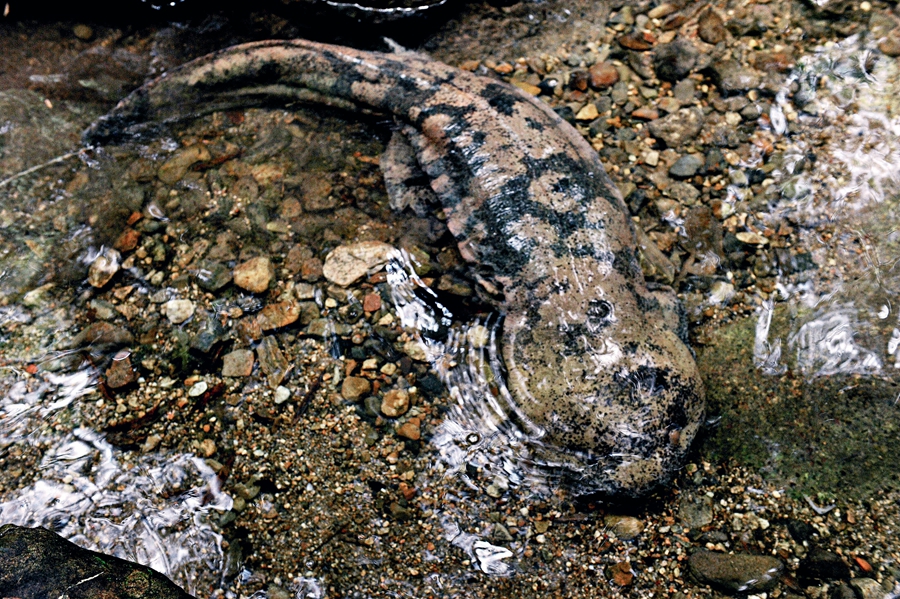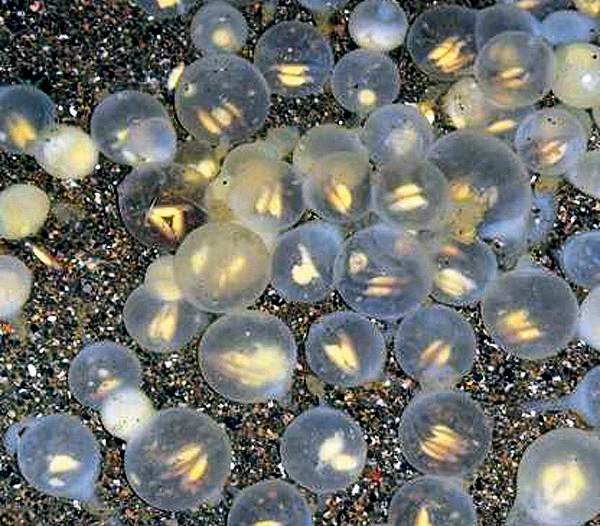By JIANG FUMEI
By JIANG FUMEI
IN the mountain streams and rivers in the middle and lower reaches of the Yangtze River, the Yellow River, and the Pearl River in China, there lives a kind of unique amphibian – the Chinese giant salamander (Andrias davidianus). With short and flat webbed limbs, this amphibian has short forearms resembling those of a child, and similarly enough, sounds like a wailing infant.
Biologists believe that the giant salamander originated around 350 million years ago, existing around the same period as the dinosaurs. Due to the duration of its existence, it is also referred to as a “living fossil”.
In 2002, archaeologists discovered a 165-million-year-old zoolite in the Jurassic era strata of Ningcheng County of China’s Inner Mongolia Autonomous Region, which is believed to be the ancestor of the giant salamander. Today’s giant salamanders are generally about 60-70 cm in length and weigh about 5-6 kg. In Hunan Province, a salamander with a length of 2.1 meters and a weight of 65 kg was captured. Archaeologists believe that their ancestors were much larger than the salamanders of today.

Some ancient Chinese books about 2,000 years ago recorded that “the giant salamander has four legs; lives like a softshell turtle and moves quickly by use of its limbs, looks similar to fish, and sounds like a wailing infant.” The body is divided into the head, trunk, limbs, and tail. Its head is flat and blunt, with a large mouth, and underdeveloped eyes without eyelids. The front part of the body is flat, gradually curving to form the tail, with fins on both sides. The salamander’s body features wrinkly skin, with five fingers on the upper limb and four on the lower, separated with slight webbing to help them in the water. The skin on the body surface is relatively smooth, with small pods that secrete white, pulp-like peppery mucus upon stimulation. A giant salamander can adapt the color of its body depending on the environment where it lives. Its natural skin tone is usually brown, reddish brown, or dark brown, and the belly is light brown or grayish white.
It has vestigial lungs, so it is similar to a frog, using moist skin to exchange gas as an assisted form of breathing. From the viewpoint of biological evolution, this occurs when a species, such as fish, transitions from living in the water to true land based creatures.
Giant salamanders typically live in mountain streams due to their cool and rapid flows, and numerous crevices and caves. When not in the water, these creatures sometimes move by crawling on tree roots or on fallen tree trunks. Giant salamanders’ dens are generally close to water bodies, and usually only one giant salamander lives in each den. These amphibians require the water temperature to be between 0°C and 26°C. If the water temperature is too high, it will choose to sleep during the summer; when it is too low, it will also reduce activities, and even hibernate until the spring.
Giant salamanders often hide in dens during the day, with their heads facing outwards, always ready for action, such as scouting for food or hiding from enemies. If they spot danger, they flee the den and swim deep into the water. Activities and predation usually occur during the evening. Giant salamanders like to eat fish, frogs, crabs, snakes, shrimps, earthworms, and aquatic insects. Sometimes they also eat birds and rodents.
Despite their appearance, these creatures can be quite ferocious when hunting, waiting quietly behind the rocks in the stream for their ideal moment to strike. When the prey passes by, the giant salamander suddenly launches an attack. Due to its sharp and dense teeth, the prey usually dies quickly after the salamander gets ahold of it. Due to the slow metabolism, it is very resistant to hunger when there is a lack of food, and can often go for two to three years without eating. Their lifetime is long and they can generally live for 50 to 60 years, or even up to 130 years.

The eggs mainly spawn during the night, with as many as 400-1,500 eggs spawning at a time.
The giant salamander breeds from May to August each year, but the males and females are difficult to distinguish solely based on appearance. Males do not scream, and from extensive research, there doesn’t appear to be any sort of mating behavior. Instead, males produce blobs of sperm called spermatophores, and the females then take these spermatophores into their bodies to fertilize their eggs. Males perform extremely important tasks in the breeding of their offspring. Not only do they need to actively attract and tease females, they are also responsible for designating appropriate caves as “delivery rooms” for hatching the eggs. These eggs mainly spawn during the night, with as many as 400-1,500 eggs spawning at a time. After laying the eggs, the female leaves the cave while the male remains. It often bends its body into a semi-circle to surround the eggs, or wraps itself around them to protect them from being washed away by water or being attacked by natural enemies. The period of incubation is 30-40 days and sometimes up to 80 days, varying with the water temperature.
The newly hatched babies resemble a tadpole, with nostrils on the head, and external gills on the neck – from which respiration is carried out. The ellipsoidal abdomen is filled with a yolk-like material, which is its main source of nutrition for the first year after its birth. When the yolk disappears in the second year, it begins to hunt for its own food, usually worms floating on the surface of the water. In the third year, the outer gills disappear, the lungs form, and maturity is reached. When they get bigger, they usually start hunting all kinds of fish, shrimps, and crabs. In the fifth year, the giant salamander is considered sexually developed.
Although the living requirements of the giant salamander are quite specific, it can still be widely found throughout many mountainous areas in China. The three major river basins in China, the middle and lower reaches of the Yellow River, the Yangtze River, and the Pearl River and their tributaries, Beijing’s Huairou District in the north, Gansu and Qinghai provinces in the west, and Guangdong and Guangxi in the south, all have giant salamanders.
However, as its habitat continues to be fragmented, giant salamanders face the danger of becoming an endangered species. As early as 1959, the giant salamander was identified by the Chinese government as an animal to be accorded top national-level protection. In 1988, it was again listed as a second-class national protected animal. In the 1990s, there were about 15 national-level conservation areas for the giant salamander in China. In 2004, the International Union for the Conservation of Nature (IUCN) included the Chinese giant salamander in the Red List of Critically Endangered Species.
Fortunately, China has entered a new era of returning farmlands to forests and comprehensively protecting the ecological environment. Lush foliage and clear streams have created a good habitat for the giant salamander, bringing about the rejuvenation of its population. At present, the national conservation areas have been expanded to 21, including two national-level conservation areas in Zhangjiajie, Hunan Province and Taibai, Shaanxi Province. An increasing number of places continues to turn up with evidence of the presence of the giant salamander, among which there may be an undiscovered wild species, as well as possible descendants from artificial breeding.
JIANG FUMEI is a Beijing-based freelancer.